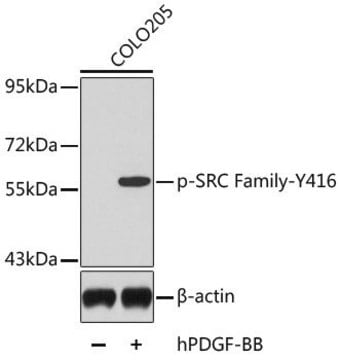05-677
Anti-phospho-Src (Tyr416) Antibody, clone 9A6
clone 9A6, Upstate®, from mouse
Synonym(s):
proto-oncogene tyrosine-protein kinase SRC, protooncogene SRC, Rous sarcoma, tyrosine kinase pp60c-src, tyrosine-protein kinase SRC-1, v-src avian sarcoma (Schmidt-Ruppin A-2) viral oncogene homolog, v-src sarcoma (Schmidt-Ruppin A-2) viral oncogene homo
About This Item
Recommended Products
biological source
mouse
Quality Level
antibody form
purified immunoglobulin
antibody product type
primary antibodies
clone
9A6, monoclonal
species reactivity
mouse, human
manufacturer/tradename
Upstate®
technique(s)
immunoprecipitation (IP): suitable
western blot: suitable
isotype
IgG3
NCBI accession no.
UniProt accession no.
shipped in
wet ice
target post-translational modification
phosphorylation (pTyr416)
Gene Information
human ... SRC(6714)
Related Categories
General description
Specificity
Immunogen
Application
Signaling
Cytoskeletal Signaling
Quality
Src Autophosphorylation/Western Blotting Analysis: 0.5-2 μg/mL of this antibody strongly detected recombinant Src (Catalog # 14-326) after incubation with Mg/Mn/ATP. Phospho-specificity was confirmed by dephosphorylation of the Src protein with λ-phosphatase.
Target description
Physical form
Storage and Stability
Analysis Note
Chick embryo fibroblast (CEF) cells expressing human wild-type Src protein
Other Notes
Legal Information
Disclaimer
Not finding the right product?
Try our Product Selector Tool.
Storage Class Code
11 - Combustible Solids
WGK
WGK 3
Certificates of Analysis (COA)
Search for Certificates of Analysis (COA) by entering the products Lot/Batch Number. Lot and Batch Numbers can be found on a product’s label following the words ‘Lot’ or ‘Batch’.
Already Own This Product?
Find documentation for the products that you have recently purchased in the Document Library.
Our team of scientists has experience in all areas of research including Life Science, Material Science, Chemical Synthesis, Chromatography, Analytical and many others.
Contact Technical Service








